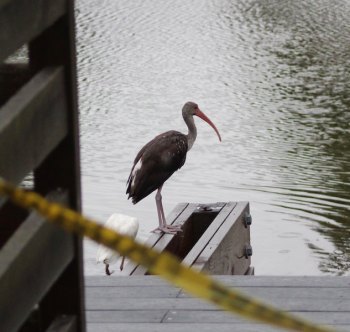Ibis Seeing You
As I left work I walked behind a man and a woman who were also walking to their vehicle. The crosswalk between the Visitor Center ramp and 1-hour parking lot always – and I mean always – floods when it rains. Since we’d had a good rain overnight a large pond had formed, and as this couple walked through it, the man couldn’t help himself and splashed his way through. His wife turned to me, head shaking, and jokingly said, “Kids!” But humans aren’t the only species which enjoys rain water collection.
American white ibis (Eudocimus albus – there I go being all science-y) are large wading birds that are almost completely white except for the black feathers on the tips of their wings. They have long orange legs and feet which match in color with their long curvy bill and the rear end of their football-shaped bodies bob up and down as they walk. Juvenile white ibis are covered in light brown feathers and their bills and legs are more of a peachy color than bright orange. These birds live in freshwater marshes, coastal estuaries, mangroves, flooded pastures and yards, swamps, and mudflats spanning from Virginia down the East Coast, into the Gulf of Mexico, and farther south to Central and South America. American white ibis can be observed in these areas year round, but some winter along the southern and western coasts of Mexico.

Around Ocracoke you can see these birds walking around in sizeable groups while intermingling with ducks, sea gulls, egrets, herons, and other coastal birds. Female ibis are about 25% lighter than males and most of their physical attributes are in proportion with their bodies. Males, however, have a much bigger bill and can therefore forage in deeper water. Sometimes ibis even work alongside other long-legged waders to forage the maximum amount of food. As they forage for insects, worms, frogs, small fish, snails, and crustaceans, they move slowly through standing water or over damp ground, keeping their heads down. But, interestingly, they do not use sight to find food. Instead, they find food by using sensors in their bills. When anything moves they’re able to feel the resulting vibrations and follow those vibrations to locate their meals.
White ibis spook really easily, but once they’ve determined there’s nothing truly threatening, they go back to foraging. I’ve noticed spooking large numbers of ibis from inside the Visitor Center. The birds are all over the yard on all sides of the building after a good rain, so no matter what we can see them regardless of where we are. Anytime I move a blind up or they are looking at the window and see me move, off they go! If they get really really spooked, they’ll fly away. While in flight their long necks are stretched straight out and their legs shoot out behind them. Honestly, they look quite silly, but with their wings in use you can easily spot their black-tipped wings.

White ibis are active during the day and get most of their sleep at night. When they sleep – whether it’s a nap or overnight – they do so standing up with their heads tucked into their wings. They are keen to set up nesting and sleeping sites away from predators, often times using marsh grasses to hide. They’ll also rest in open area, such as in the Visitor Center yard, as long as there are no nearby threats. Reproduction begins in their third year of life and white ibis can live between 16 and 20 years.
Ocracoke has white ibis year-round and I’ve frequently seen them along ORV Ramp 72, by the Berkeley Manor driveway, the NPS Visitor Center and Campground, and even in some yards that collect rain water.




